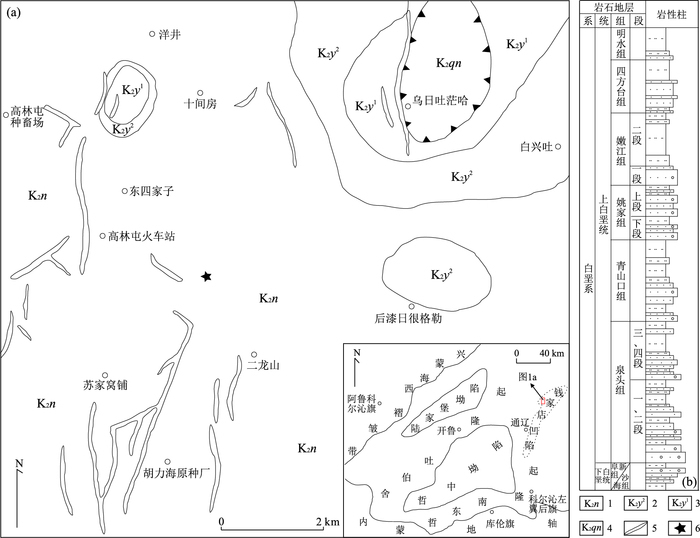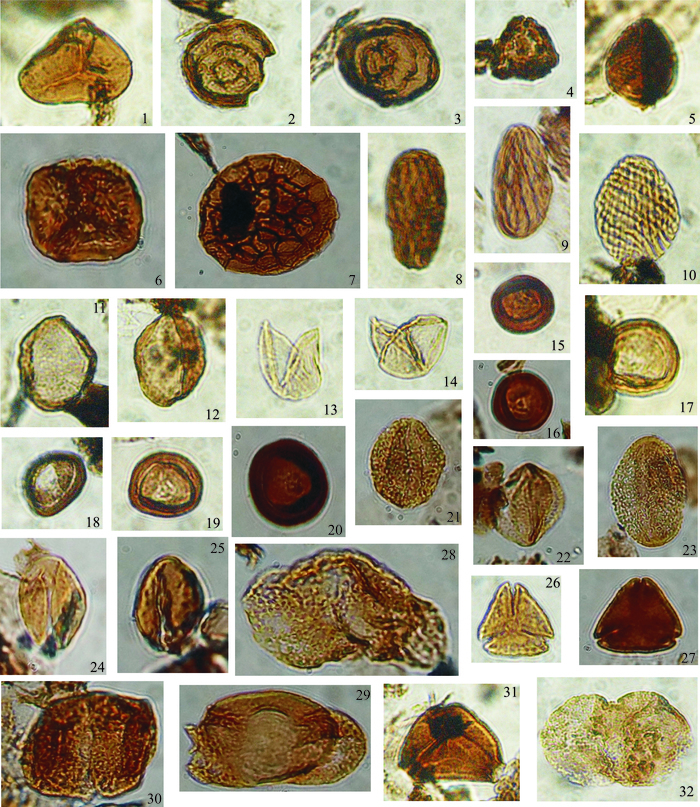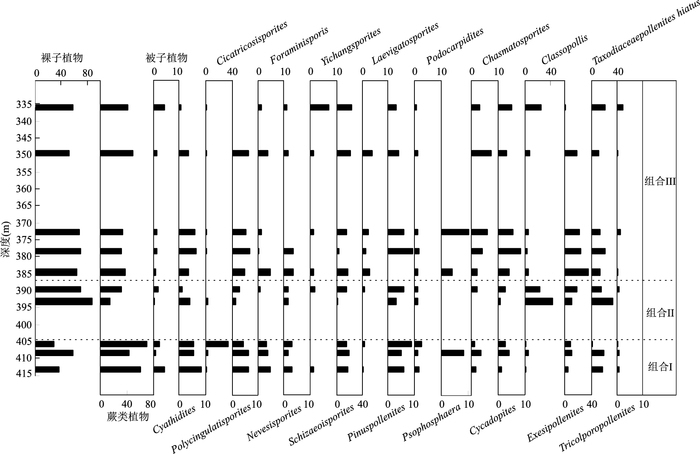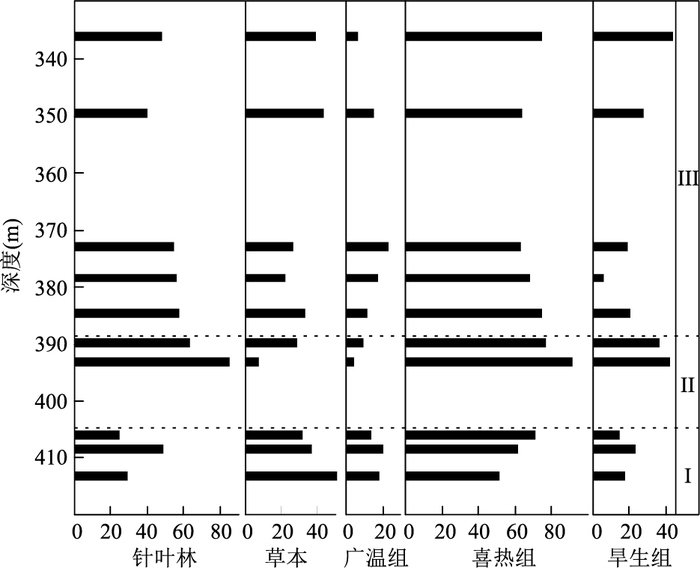Late Cretaceous Palynological Assemblage and Its Palaeoclimate Record from Yaojia Formation in Qianjiadian Depression, Kailu Basin
-
摘要: 对于开鲁盆地姚家组孢粉学的研究不仅丰富了该地区晚白垩世孢粉学资料,而且为该地区晚白垩世地层划分与对比提供了依据.通过对开鲁盆地钱家店凹陷钻孔QIV-48-61深315~447 m井段的岩心做了详细采样、描述,并进行了孢粉化石的处理、鉴定和分析,在其中的10个层位中发现了丰富的孢粉化石,共计73属88种,并建立了3个孢粉组合,自下而上依次为Schizaeoisporites-Cyathidites-Tricolpopollenites,Schizaeoisporites-Classopollis-Taxodiaceaepollenites和Schizaeoisporites-Exesipollenties-Tricolpopollenites,根据孢粉组合内一些重要分子的地质时限及与外区有关孢粉组合的对比,将其时代划归为晚白垩世Coniacian晚期-Santonian早期,其层位相当于姚家组.根据孢粉母体植物形态和生态特征、干湿度环境和气候环境,将其孢粉植物群反映的植被、干湿度和气候带划分为3个演化阶段:第1演化阶段(405.9~413.2 m)沉积时期植被面貌大体为针叶林与草本共生,对应于湿润、半湿润的热带-亚热带气候;第2演化阶段(389.7~405.9 m)植被面貌演化为以高大乔木型针叶树种占优势地位,并出现一次明显的干旱化事件,对应于半干旱的热带-亚热带气候;第3演化阶段(336.0~389.7 m)植被面貌与第1阶段相似,为针叶林与草本共生,干旱化有所缓解,对应于半湿润-半干旱的热带-亚热带气候.Abstract: The study on the palynology from the Yaojia Formation can provide palynology data and lay the basis on Late Cretaceous stratigraphic classification and correlation in the northeastern area of Kailu basin. Abundant sporopollen fossils of 88 species from 73 genera were recognized from the interval of 315 to 447 m of well QIV-48-61 in the Qianjiadian depression, Kailu basin in this study. Three sporopollen assemblages are established, namely the Schizaeoisporites-Cyathidites-Tricolpopollenites assemblage, the Schizaeoisporites-Classopollis-Taxodiaceaepollenites assemblage and the Schizaeoisporites-Exesipollenties-Tricolpopollenites assemblage. According to the geological range of some important elements and the correlation with relevant assemblages of other areas, the geological era of these sporopollen assemblages is assigned to the Late Cretaceous, which is equal to the Late Coniacian-Early Santonian Stage. Based on ecological characteristics, climate and humidity condition for the vegetation type of the sporopollen from the Qianjiadian area, 3 phases of paleovegetation and paleoclimate are reconstructed as follows. (1) It was humid/semi-humid tropic-subtropic climate during the interval of 405.9 to 413.2 m, presenting a vegetation landscape of coniferous forest and grass. (2) The vegetation type during the interval of 389.7 to 405.9 m was characterized by the dominance of coniferous forest, and the climate turned hot and dry, marked by the increase in the drought-tolerant taxa, corresponding to semi-arid tropic-subtropic climate. (3) Similar to the first phase, the vegetation type during the interval of 336.0 to 389.7 m was also coniferous forest including grass, which belonged to semi-humid and semi-arid tropic-subtropic climate.
-
Key words:
- palynological assemblage /
- palaeoclimate /
- Yaojia Formation /
- Late Cretaceous /
- Qianjiadian depression /
- Kailu basin /
- paleontology
-
图 1 区域地质背景及钱家店凹陷钻孔位置
a.钱家店地区前第四纪地质略图及钻孔位置;b.钱家店地区地层综合柱状图.图a据罗毅等(2012)和荣辉等(2016)修改;图b据董文明等(2007)修改.1.嫩江组;2.姚家组上段;3.姚家组下段;4.青山口组;5.辉绿岩脉;6.钻孔位置
Fig. 1. Geology background and location of the bore-hole QIV-48-61 in Qianjiadian depression
图 2 开鲁盆地东北部钱家店凹陷晚白垩世姚家组代表性孢粉化石
化石照片放大600倍.1.Deltoidospora;2, 3.Yichangsporites;4.Pterisisporites;5.Cicatricosisporites;6.Nevesisporites;7.Zlivisporis;8, 9, 10.Schizaeoisporites;11, 12.Chasmatosporites;13, 14.Taxodiaceaepollenites hiatus;15, 16, 17, 18, 19, 20.Classopollis annulatus;21, 22, 23.Retitricolpites;24, 25.Cycadopites;26, 27.Tricolporopollenites;28, 29.Abietineaepollenites/Pinuspollenites;30.Parcisporites;31.Lythraites;32.Podocarpidites
Fig. 2. Late Cretaceous representative sporopollen from Yaojia Formation in Qianjiadian depression
表 1 开鲁盆地东北部钱家店凹陷晚白垩世姚家组孢粉统计
Table 1. Statistics of sporopollen from Late Cretaceous Yaojia Formation in Qianjiadian depression
化石名单 井深(m) 336 349.5 372.8 378.4 384.6 389.7 393.2 405.9 408.5 413.2 430.6 蕨类植物孢子 28.20 42.99 28.90 25.73 31.77 26.55 10.24 67.95 36.43 50.74 85.71 Sphagnumsporites sp. 0.30 0.65 0.25 0.24 0.49 Deltoidospora sp. 0.65 0.13 0.48 0.96 0.27 Cyathidites sp. 3.12 4.91 2.91 2.82 0.63 2.86 3.21 4.40 5.41 C. minor 0.30 2.43 0.25 1.60 1.62 Toroisporis sp. 0.62 0.29 0.24 0.49 Undulatisporites sp. 0.31 0.16 Cibotiumspora sp. 0.16 0.24 Granulatisporites sp. 0.32 0.51 0.24 0.64 Acanthotriletes sp. 0.31 Lophotriletes sp. 0.49 0.38 1.19 0.32 0.81 Converrucosisporites sp. 0.54 Conbaculatisporites sp. 0.41 Punctatisporites sp. 1.29 0.64 1.76 Cyclogranisporites sp. 1.22 0.65 1.14 0.64 2.84 Apiculataspotires sp. 1.56 0.27 Apiculatasporites sp. 0.30 1.14 Apiculatisporis sp. 0.93 0.58 0.97 0.19 1.01 0.24 1.28 0.49 1.62 Concavissimisporites sp. 0.27 Verrucosisporites sp. 0.30 0.97 0.51 0.64 0.27 Neoraistrickia sp. 0.29 Leptolepidites sp. 0.13 Pterisisporites sp. 0.15 0.13 0.24 0.41 Polypodiaceoisporites sp. 0.24 Osmundacidites sp. 1.07 0.49 0.27 O. parvus 0.54 Retusotriletes sp. 0.30 1.25 0.87 1.46 0.56 0.63 2.24 1.96 1.35 Interulobites sp. 0.30 0.63 0.64 0.24 0.81 Zlivisporis sp. 1.52 0.62 0.58 0.38 0.38 0.64 0.73 2.71 Lycopodiumsporites sp. 0.15 0.93 0.32 0.19 0.38 0.24 0.49 1.08 Appendicisporites sp. 0.24 Cicatricosisporites sp. 0.30 0.31 0.49 0.95 31.73 0.24 0.14 C. minutaestriatus 0.29 0.73 Aequitriradites sp. 0.15 1.16 0.16 0.56 0.73 0.14 Densosporites sp. 0.30 Polycingulatisporites sp. 2.49 2.60 3.56 1.69 2.28 0.71 1.92 2.93 4.06 P. circulus 0.97 0.64 0.54 P. triangularis 0.32 P. triangularis 2.80 1.73 0.65 2.26 1.28 2.20 0.27 Densoisporites sp. 0.62 0.49 0.14 Annulispora sp. 0.48 Foraminisporis sp. 0.76 3.43 1.16 0.32 3.95 0.63 2.88 3.18 3.79 Nevesisporites sp. 0.93 0.95 0.49 N. radiatus 0.46 0.31 2.59 2.63 1.26 2.56 0.73 2.44 Yichangsporites sp. 4.88 0.62 0.58 0.94 1.26 0.95 Wulongspora sp. 0.15 Gabonisporis sp. 0.15 1.22 Schizaeoisporites sp. 15.09 9.97 8.96 1.94 11.28 12.52 0.48 12.82 14.67 13.40 85.71 S. vitilis 2.80 2.89 2.07 S. brevis 5.61 0.73 Crybelosporites sp. 0.14 Laevigatosporites sp. 3.43 2.02 0.81 2.26 0.38 0.64 0.27 裸子植物花粉 53.66 55.14 68.21 73.62 67.29 71.43 89.29 28.53 62.35 44.52 14.29 336 349.5 372.8 378.4 384.6 389.7 393.2 405.9 408.5 413.2 430.6 Abietineaepollenites sp./Pinuspollenites sp. 1.83 3.43 4.91 7.77 4.80 2.14 8.33 3.91 5.01 14.29 Parcisporites sp. 0.62 0.56 Cedripites sp. 0.93 0.29 0.38 0.32 0.24 Piceaepollenites sp. 0.29 0.32 0.88 0.24 0.64 0.73 0.27 Keteleeriaepollenites sp. 0.64 Podocarpidites sp. 0.30 0.93 0.87 1.29 0.75 0.63 0.71 2.24 0.73 1.08 Piceites sp. 0.58 0.25 1.47 Pseudopicea sp. 0.62 0.19 0.32 0.41 Protoconiferus sp. 0.30 0.49 0.63 0.96 0.27 Psophosphaera sp. 8.96 3.38 6.85 Chasmatosporites sp. 1.83 6.54 4.91 3.07 1.69 1.77 0.64 2.93 1.22 Cycadopites sp. 3.35 2.80 4.62 7.12 3.38 1.90 0.48 2.24 3.18 0.68 Classopollis sp. 23.57 C. annulatus 10.21 5.61 4.05 0.32 4.32 6.95 7.62 0.64 3.91 C. triangulus 0.91 0.62 0.38 C. parvus 6.40 2.27 11.38 0.64 0.68 Exesipollenties sp. 0.15 6.54 18.50 5.99 11.28 10.11 7.38 2.69 3.25 E. tumulus 8.41 18.61 3.54 7.05 5.38 E. pseudotriletes 12.94 2.02 0.96 0.68 Perinopollenites sp. 0.56 0.73 Jugella sp. 0.46 0.31 0.25 0.64 3.79 Brenneripollis sp. 0.13 Steevesipollenites sp. 0.31 0.58 0.24 Monosulcites sp. 0.13 0.27 Ephedripites sp. 0.24 Taxodiaceaepollenites hiatus 13.72 8.72 9.83 16.02 11.28 12.52 23.57 0.96 14.67 13.40 Araucariacites sp. 0.46 0.25 0.32 0.14 被子植物花粉 2.74 1.25 1.16 0.81 0.56 1.26 0.24 1.92 0.73 3.65 Myrtaceidites sp. 0.32 0.25 0.64 0.81 Cranwellia sp. 0.24 0.68 C. striatus 0.54 Proteacidites sp. 0.16 0.51 0.64 0.81 Symplocospollenites sp. 0.27 Lythraites sp. 0.15 Triporopollenites sp. 1.68 0.31 1.16 0.38 0.38 0.32 0.73 0.41 Tricolporopollenites sp. 0.91 0.32 0.14 Retitricolpites sp. 0.93 Quantonenpollenites sp. 0.19 0.13 0.32 每块样品鉴定化石数量(粒) 656 321 346 618 532 791 420 312 409 739 7 -
Archangelsky, S., Gamerro, J.C., 1967.Spore and Pollen Type of the Lower Cretaceous in Patagonia.Review of Palaeobotany and Palynology, 1(1-4):211-217.doi: 10.1016/0034-6667(67)90123-6 Bian, Y.M., Yu, J., Shao, Z.G., et al., 2013.Palynological Assemblages in the Paiku Co Basin of Tibet since Late Pleistocene and Their Paleoclimatic Significance.Acta Geoscientica Sinica, 34(1):87-94 (in Chinese with English abstract). Bolchovitina, N.A., 1967.The Fossil Spores of the Family Gleicheniaceae (Morphology and Taxonomy).Review of Palaeobotany and Palynology, 3(1-4):59-64.doi: 10.1016/0034-6667(67)90039-5 Burger, D., 1980.Palynological Studies in the Lower Cretaceous in the Surat Basin, Australian.Bureau of Mineralogical Resources Bulletin, 189:1-106. Cao, L., 1990.Discovery of Late Cretaceous Palynoflora from Fildes Peninsula, King George Island, Antarctica and Its Significance.Acta Palaeontologica Sinica, 29(2):140-146 (in Chinese with English abstract). http://www.cqvip.com/QK/90074X/199002/1000024315.html Dong, W.M., Lin, J.R., Xia, Y.L., et al., 2007.Sequence Stratigraphy of the Upper Cretaceous and Its Relation to Sandstone-Type Uranium Mineralization in the Southwest of Songliao Basin.World Nuclear Geoscience, 24(3):125-135 (in Chinese with English abstract). http://www.academia.edu/7309810/Hydrogeology_sequence_stratigraphy_and_diagenesis_in_the_Paleoproterozoic_western_Thelon_Basin_Influences_on_unconformity-related_uranium_mineralization Doyle, J.A., 1969, Cretaceous Angiosperm Pollen of the Atlantic Coastal Plain and Its Evolutionary Significance.Journal of the Arnold Arboretum Arnold Arboretum, 50(1):1-35.doi: 10.5962/bhl.part.24686 Friedrich, O., Norris, R.D., Erbacher, J., 2012.Evolution of Middle to Late Cretaceous Oceans a 55 m.y.Record of Earth's Temperature and Carbon Cycle.Geology, 40(2):107-110.doi: 10.1130/G32701.1 Huang, Q.H., Zheng, Y.L., Yang, M.J., et al., 1999.On Cretaceous Paleoclimate in the Songliao Basin.Acta Micropalaeontologica Sinica, 16(1):95-103 (in Chinese with English abstract). Huber, B.T., Norris, R.D., Macleod, K.G., 2002.Deep-Sea Paleotemperature Record of Extreme Warmth during the Cretaceous.Geology, 30(2):123-126.doi:10.1130/0091-7613(2002)030<0123:DSPROE>2.0.CO; 2 Li, J.G., Zhang, Y.Y., Cai, H.W., et al., 2008.Cretaceous and Paleogene Palynological Successions at Zhongba, Tibet and Its Significance.Acta Geologica Sinica, 82(5):584-593 (in Chinese with English abstract). Luo, Y., He, Z.B., Ma, H.F., et al., 2012.Metallogenic Characteristics of Qianjiadian Sandstone Uranium Deposit in Songliao Basin.Mineral Deposits, 31(2):391-400 (in Chinese with English abstract). Miller, K.G., Wright, J.D., Browning, J.V., 2005.Visions of Ice Sheets in a Greenhouse World.Marine Geology, 217(3-4):215-231.doi: 10.1016/j.margeo.2005.02.007 Muller, J., 1970.Palynological Evidence on Early Differentiation of Angiosperm.Biological Reviews, 45(3):417-450.doi: 10.1111/j.1469-185X.1970.tb01649.x Norris, G., Jarzen, D.M., Awai-Thorne, B.V., 1975.Evolution of the Cretaceous Terrestrial Palynoflorain Western Canada.Geological Association of Canada Special Paper, 13:333-364. Rong, H., Jiao, Y.Q., Wu, L.Q., et al., 2016.Epigenetic Alteration and Its Constraints on Uranium Mineralization from the Qianjiadian Uranium Deposit, Southern Songliao Basin.Earth Science, 41(1):153-166 (in Chinese with English abstract). http://www.bookmetrix.com/detail/chapter/0b43d42b-2612-4897-a6fe-d1b53f9a1d0b Skelton, P.W., 2003.The Cretaceous World.Cambridge University Press, London, 350. Song, Z.C., 1986.A Review on the Study of Early Cretaceous Angiosperm Pollen in China.Acta Micropalaeontologica Sinica, 3(4):373-386 (in Chinese with English abstract). Song, Z.C., Qian, Z.S., 1989.Spores and Pollen Grains from Taizhou Group of North Jiangsu.In:Institute of Geology, Jiangsu Oil Exploration and Development Corporation, Nanjing Institute of Geology and Palaeonotology, Chinese Academy of Sciences, eds., Stratigraphy and Palaeontology of the Taizhou Formation and the First Member of the Funing Formation, North Jiangsu Basin.Nanjing University Press, Nanjing, 33-110 (in Chinese). Song, Z.C., Zheng, Y.H., Liu, J.L., et al., 1981.Cretaceous and Tertiary Palynological Successions of the Jiangsu Area.Geological Publishing House, Beijing, 268 (in Chinese). Stover, L.E., 1963.Some Middle Cretaceous Palynomorphs from West Africa.Micropaleontology, 9(1):85-94.doi: 10.2307/1484611 Wan, C.B., 2006.Cretaceous Palynological Flora in Hailar Basin (Dissertation).Jilin University, Changchun (in Chinese with English abstract). Wang, D.N., Sun, X.Y., Zhao, Y.N., et al., 1990.Palynoflora from Late Cretaceous to Tertiary in Some Regions of Qinghai and Xinjiang.In:The Institute of Geology, Chinese Academy of Geological Sciences, Institute of Petroleum Exploration and Exploitation, Administrative Bureae of Petroleum, Xinjiang, eds., The Study on the Micropaleobotany from Cretaceous-Tertiary of the Oil Bearing Basin in Some Regions of Qinghai and Xinjiang (Part Ⅰ).China Environmental Science Press, Beijing, 1-158 (in Chinese). Wang, K.F., Zhang, Y.L., Jiang, H., et al., 1989.Cretaceous-Tertiary Sporo-Pollen Assemblages of Zhejiang with Their Paleovegetation and Paleoclimate.Acta Palaeontologica Sinica, 28(5):653-662 (in Chinese with English abstract). doi: 10.1134/S0869593815030028 Wang, Y.D., Huang, C.M., Sun, B.N., et al., 2014.Paleo-CO2 Variation Trends and the Cretaceous Greenhouse Climate.Earth-Science Reviews, 129(1):136-147.doi: 10.1016/j.earscirev.2013.11.001 Wilson, .P A., Norris, R.D., 2001.Warm Tropical Ocean Surface and Global Anoxia during the Mid-Cretaceous Period.Nature, 412(6845):425-429.doi: 10.1038/35086553 Wu, B.W., 2006.Early Cretaceous Spores and Pollen Assemblages of Kailu Basin, Nei Mongol.Acta Palaeontologica Sinica, 45(4):549-562 (in Chinese with English abstract). Wu, B.W., 2007.Discovery of the Three Cretaceous Biotas in the Kailu Basin of Inner Mongolia and Their Geological Significance.Journal of Stratigraphy, 31(3):280-287 (in Chinese with English abstract). https://academic.oup.com/nsr/article-abstract/1/4/521/1512656/Mesozoic-mammals-of-China-implications-for Wu, B.W., 2014.Late Cretaceous Palynoflora from the Nenjiang Formation in the Kailu Basin.Acta Micropalaeontologica Sinica, 31(3):303-310 (in Chinese with English abstract). doi: 10.1007/s11430-014-4846-z Yao, Y.M., Liang, H.D., Cai, Z.G., et al., 1994.Tertiary in Petroliferous Regions of China.IV, The Bohai Gulf Basin.Petroleum Industry Press, Beijing, 240 (in Chinese). Yu, J.X., 1981.Late Cretaceous Sporo-Pollen Assemblages of Shache District, Xinjiang.Acta Geologica Sinica, (2):93-104 (in Chinese with English abstract). Zhang, Y.Y., Zhan, J.Z., 1991.Late Cretaceous and Tertiary Spores and Pollen from the Western Tarim Basin, Xinjiang, China.Science Press, Beijing, 398 (in Chinese). Zhao, J., 2013.Late Cretaceous Palynology (Spores, Pollen, Algae), Climate, and Lacustrine Conditions in Songliao Basin (Dissertation).China University of Geosciences, Beijing (in Chinese with English abstract). Zhu, L.X., Tan, F.W., Fu, X.G., et al., 2012.Strata of the Late Mesozoic in the North of Qiangtang Basin:A Discovery of the Early Cretaceous Marine Strata.Acta Sedimentologica Sinica, 30(5):825-833 (in Chinese with English abstract). 边彦明, 余佳, 邵兆刚, 等, 2013.西藏佩枯错盆地晚更新世以来的孢粉组合特征及其古气候意义.地球学报, 34(1): 87-94. doi: 10.3975/cagsb.2013.01.08 曹流, 1990.南极乔治王岛菲尔德斯半岛晚白垩世孢粉植物群的发现及其意义.古生物学报, 29(2): 140-146. http://www.cnki.com.cn/Article/CJFDTOTAL-GSWX199002001.htm 董文明, 林锦荣, 夏毓亮, 等, 2007.松辽盆地西南部上白垩统层序地层特征与砂岩型铀成矿作用.世界核地质科学, 24(3): 125-135. http://www.cnki.com.cn/Article/CJFDTOTAL-GWYD200703003.htm 黄清华, 郑玉龙, 杨明杰, 等, 1999.松辽盆地白垩纪古气候研究.微体古生物学报, 16(1): 95-103. http://www.cnki.com.cn/Article/CJFDTOTAL-WSGT901.010.htm 李建国, 张一勇, 蔡华伟, 等, 2008.西藏仲巴白垩纪-古近纪孢粉组合及其意义.地质学报, 82(5): 584-593. http://www.cnki.com.cn/Article/CJFDTOTAL-DZXE200805003.htm 罗毅, 何中波, 马汉峰, 等, 2012.松辽盆地钱家店砂岩型铀矿成矿地质特征.矿床地质, 31(2): 391-400. http://www.cnki.com.cn/Article/CJFDTOTAL-KCDZ201202019.htm 荣辉, 焦养泉, 吴立群, 等, 2016.松辽盆地南部钱家店铀矿床后生蚀变作用及其对铀成矿的约束.地球科学, 41(1): 153-166. http://earth-science.net/WebPage/Article.aspx?id=3228 宋之琛, 1986.我国早白垩世被子植物花粉研究之回顾.微体古生物学报, 3(4): 373-386. http://www.cnki.com.cn/Article/CJFDTOTAL-WSGT198604004.htm 宋之琛, 钱泽书, 1989.苏北盆地泰州组孢粉研究.见:江苏石油勘探局地质科学研究所, 中国科学院南京地质古生物研究所编, 苏北盆地泰州组、阜宁组一段地层古生物.南京:南京大学出版社, 33-110. 宋之琛, 郑亚慧, 刘金陵, 等, 1981.江苏地区白垩纪-第三纪孢粉组合.北京:地质出版社, 268. 万传彪, 2006. 海拉尔盆地白垩纪孢粉植物群(博士学位论文). 长春: 吉林大学. http://cdmd.cnki.com.cn/Article/CDMD-10183-2006109789.htm 王大宁, 孙秀玉, 赵英娘, 等, 1990.青海-新疆部分地区晚白垩世-第三纪孢粉植物群研究.见:中国地质科学院地质研究所, 新疆石油管理局勘探开发研究院编, 青海、新疆部分地区晚白垩世-第三纪含油盆地微古植物群的研究.北京:中国环境科学出版社, 1-158. 王开发, 张玉兰, 蒋辉, 等, 1989.浙江白垩-第三纪孢粉组合及其古植被、古气候.古生物学报, 28(5): 653-662. http://www.cnki.com.cn/Article/CJFDTOTAL-GSWX198905012.htm 吴炳伟, 2006.内蒙古开鲁盆地早白垩世孢粉组合.古生物学报, 45(4): 549-562. http://www.cnki.com.cn/Article/CJFDTOTAL-GSWX200604011.htm 吴炳伟, 2007.内蒙古开鲁盆地白垩纪三大生物群的发现及其地质意义.地层学杂志, 31(3): 280-287. http://www.cnki.com.cn/Article/CJFDTOTAL-DCXZ200703011.htm 吴炳伟, 2014.内蒙古东南部开鲁盆地晚白垩世嫩江组孢粉植物群.微体古生物学报, 31(3): 303-310. http://www.cnki.com.cn/Article/CJFDTOTAL-WSGT201403010.htm 姚益民, 梁鸿德, 蔡治国, 等, 1994.中国油气区第三系(Ⅳ)渤海湾盆地油气区分册.北京:石油工业出版社, 240. 余静贤, 1981.新疆莎车地区晚白垩世孢粉组合.地质学报, (2): 93-104. http://www.cnki.com.cn/Article/CJFDTOTAL-DZXE198102001.htm 张一勇, 詹家祯, 1991.新疆塔里木盆地西部晚白垩世至第三纪孢粉.北京:科学出版社, 398. 赵静, 2013. 松辽盆地晚白垩世早-中期孢粉藻类及古气候古湖泊条件(博士学位论文). 北京: 中国地质大学. https://www.cnki.com.cn/lunwen-1013267273.html 朱丽霞, 谭富文, 付修根, 等, 2012.北羌塘盆地晚中生代地层:早白垩世海相地层的发现.沉积学报, 30(5): 825-833. http://www.cnki.com.cn/Article/CJFDTOTAL-CJXB201205006.htm -










 下载:
下载:




